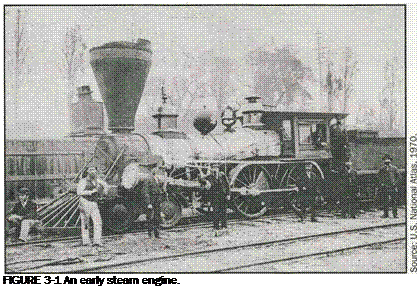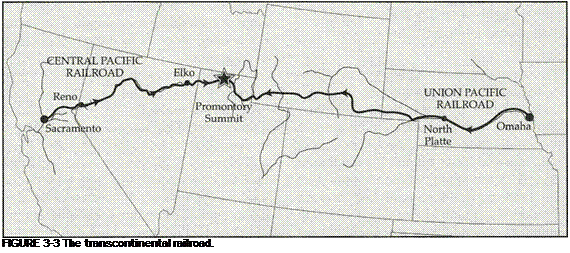he steam engine, first fitted to a wagon in 1804, evolved into a primitive railroad locomotive to pull the first railroad carriages in 1830. (See Figure 3-1.) The first chartered railroad, the Baltimore & Ohio Railroad, operated from Baltimore to Ellicott’s Mills, a distance of just 13 miles. Short-haul railroads like this began springing up all over the East Coast of the United States about this time. The noisy, dirty, and generally terrifying apparition of an early steam locomotive, spitting steam and hot coal cinders in its wake and upon the few discomfited passengers who may have been loaded in the open cars behind it, rudely intruded on the sedate horse and buggy countryside. Yet few questioned its future. It was, after all, the most significant transportation advance in the history of the world, even at its maximum speed of 16 miles per hour, and even though it had the worrisome tendency of setting fire to the countryside through which it passed.
Like most inventions, the locomotive was gradually improved through the contributions of many people until it worked smoothly and readily achieved its designed purpose. This was advanced technology. The various small lines began meeting up, forming interchange points and exchanging the relatively small amount of freight traffic available. Passenger service was tentative, and the destinations sparse. These early
rail lines were constructed to meet local needs, and there was no overall plan for lines to serve the nation or any particular geographic region.
Railroads were considered, legally and practically, to be monopolistic enterprises. The large capital investment required to begin operations virtually guaranteed little competition. Land had to be purchased, then the land had to be made level—requiring fills or bridges to connect over low places, valleys, and rivers, and causing cuts or tunnels to be dug to eliminate hills and mountains. Once that was done, the roadbed, consisting of ballast, ties, and finally the rails themselves, had to be laid. This process was required in one form or another for every linear foot of road. Even as the road was laid, and large sums of money spent, the question was unanswered: How should and would the government consider this new industry?
This was a time of forging new relationships all around, relationships that, once defined, would extend into the as-yet-unimagined air age of the future.
• What was the responsibility of a railroad to passengers and shippers?
• Was there any responsibility to communities served?
• Where was the higher allegiance—to stockholders or to the public?
 |
Prior to the construction of the great transcontinental road that linked the West Coast of the United States with the Midwest, government had generally refrained from intervening in the affairs of the infant railroad industry. There was no federal governmental interest in railroad regulation since, in the early 19th century, federal issues like the “public interest” or “interstate commerce” had yet to be framed. Local governments treated the small railroads as any other business. When it would later come, federal government intervention would be characterized as either “positive” or “negative.” Positive intervention could be described as government action that is designed to support or benefit the railroad, such as favorable tax treatment, subsidies, land grants, and the like. Negative intervention takes the form of restrictive legislation, the curbing of pre-existing rights enjoyed by the railroads, and the forcing of certain behavior deemed to be in the public interest, such as prohibiting arbitrary or unequal treatment of shippers.
The sheer magnitude of the proposed transcontinental railroad construction dictated that the government’s participation would be required.
No corporation, group of corporations, bank, or group of banks was big enough to make it happen. Only the government was big enough, and only the government had the money and other resources necessary (including the land), and the sovereignty necessary to assuage the conflicts, partisanship, separate interests, and legal questions guaranteed to arise in the vast undertaking.
The western land over which most of the transcontinental railroad would run was composed of acquisitions by the government beginning in 1803. Known as the “Louisiana Purchase” (see Figure 3-2), this vast tract consisted of over 800,000 square miles that extended from the Gulf of Mexico to the Canadian border and from the Mississippi River to the Rocky Mountains. The land area of the United States was doubled. Fifteen new states, in whole or in part, would come from this tract.
In three years between 1845 and 1848, the land area of the United States would be enlarged again by a third, as the State of Texas was annexed in 1845, the Oregon Territory was negotiated with England in 1846, and the great southwestern territory was ceded by Mexico to
the United States in 1848. The United States now extended all the way across the continent, from sea to shining sea.
The passage by the Congress in 1862 of the Pacific Railroad Act became the first of government’s involvements in the world of modern transportation. The law provided for the creation of two private corporations, the Union Pacific (building from the East) and the Central Pacific (building from the West), whose charters were to build a railroad and a telegraph line’ between the Missouri River and Sacramento, California. The government would issue its bonds, bearing interest at the rate of 6 percent, to the railroads
RI1790 CT 1788 NJ 1787 MD 1788 DE 1787
for sale to the public. The improvements and the land on which they were placed would stand as security for the government’s obligation to pay the interest on the bonds and to pay the face amount of the bonds when due. The government was not subsidizing the construction; rather, it was loaning its credit in order to raise the construction funds.
The government would, however, grant to the railroads the right of way (200 feet on each side) for the roadbed, and it would also deed land adjacent to the right of way in square miles amounting to 6,400 acres per mile. This was land expected to be used to entice settlers from the East who would create and work farms and ranches. The land would be used to build towns and to provide for industry, all of which in turn would provide passenger and freight traffic for the railroads and insure westward expansion and
 population of the Great Plains and points west. This was truly a win-win situation, even for the government, since the value of the remainder of the land that the government owned would be greatly enhanced by the efforts of the railroad companies and those who would follow them. The interests of the government would also be served by facilitating a viable railroad system to serve the nation and to advance the national economy and the public welfare.
population of the Great Plains and points west. This was truly a win-win situation, even for the government, since the value of the remainder of the land that the government owned would be greatly enhanced by the efforts of the railroad companies and those who would follow them. The interests of the government would also be served by facilitating a viable railroad system to serve the nation and to advance the national economy and the public welfare.
The line began in the East on the Missouri River, at Omaha, Nebraska, and made its way west to Promontory Summit, Utah, where in 1869, the line of road that began in Sacramento, California, was joined. Along the way it laid down settlements which were to become the cities of the future, with names like Cheyenne, Laramie, North Platte, and Elko, names which 50 years later would also figure prominently in the annals of early flight as the first crosscountry air mail service struggled to create yet another, but altogether different, fledgling transportation system. This transcontinental railroad is shown in Figure 3-3. With air transport, the government, once again, would take the lead and then step out of the way, leaving the captains of industry to their own devices in making the system run.
But turmoil lay ahead. It has been said that the years between 1860 and 1868 laid the foundation for the uprooting of the society of America. The Civil War, beginning in 1861, tore the country apart for four years, and the so-called Reconstruction era that followed effectively rendered the South a land occupied by a foreign power for many years. Centuries-old traditions in both the North and the South were eradicated or radically altered. Politics and social life changed.
 |
The impact of available and relatively fast railroad transportation on the stability of the population compounded the problem. People began to move and to follow the railroads as they connected sections of the country and both coasts, and as the heartland was settled. People could more readily live and work anywhere in the country, leaving behind their pasts, their established social networks, and sometimes their principles and mores. Political power was for sale in the legislatures of the states and in Congress as graft and corruption became prevalent.
The new opportunities afforded to corporations led to a time of unbridled capitalism at the hands of rapacious men of industry like the Vanderbilts, the Goulds, and the Carnegies. The power of corporations, like the Pullman Company, Standard Oil, and United States Steel, joined with the new political structure to create a vast gulf between owners, known as the “robber barons,” and workers. Labor was set against management in an epic struggle that would poison labor relations in the railroad industry for generations to come and that would be carried over to the airlines. The government’s initial assistance, as positive legislation, would soon turn to regulation of the restrictive kind with the passage of the first comprehensive national legislation regulating transportation.












